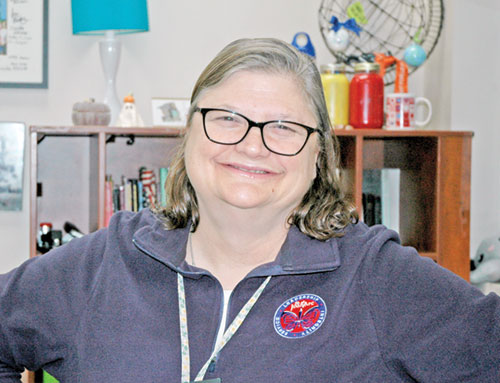2025 Catholic Schools Week Supplement
Her mom’s wedding day advice and a program on virtue guide a teacher

As a teacher at St. Joan of Arc School in Indianapolis, Estelle Britner has followed her mom’s advice to place God first and help others become better. (Photo by John Shaughnessy)
By John Shaughnessy
While 31 years have passed, Estelle Britner still remembers the advice her mother gave her on her wedding day.
“It was when I was getting dressed at home,” Britner recalls about that special moment in 1993. “My mom was in there, helping me like moms always do on girls’ wedding days. It was just the two of us. She told me, ‘Always be on the side of your husband, but God always comes first, no matter what.’ She said that she and my dad were always on the same side because God came first.”
That advice dovetailed with the example that her parents, Bob and Anne Armbruster, consistently showed to their nine children.
“Our parents molded my siblings and me to be workers for others,” says Britner, the youngest child. “My thoughts, words and actions were never exclusive to me. I had a responsibility to use them to help make others better.”
For the past 32 years, Britner has lived those two goals—placing God first and helping others become better—as a Catholic school teacher in the archdiocese. And she has taken that emphasis to an even higher level in her 11 years as a social studies teacher at St. Joan of Arc School in Indianapolis.
“When I joined the St. Joan of Arc faculty, it felt as if I had made it home. With the monikers ‘leadership, integrity and service,’ the stage was set for me to fully live what I had been taught,” says Britner, a finalist for last year’s Saint Theodore Excellence in Education Award, the highest honor the archdiocese gives an educator. “I was immediately encouraged to share my faith by highlighting faith leaders within the social studies curriculum.
“It just feels so natural that as I’m talking about historical events to also focus on the role that our faith has played in those historical events. And because it feels so natural to me, it comes across that way to the kids. It helps them see that faith is an everyday part of everything you do in your life.”
She shares the example of St. Junipero Serra and how his creation of mission churches on the west coast of the United States ties in with the development of that part of the country, bringing together the Spanish influences of Catholic faith and culture.
“It became more understandable to the kids when you talk about all the names of different cities in not only California but Texas and all the Southwest that were all colonized by the Spanish—including San Francisco, San Jose, Santa Barbara, San Antonio, Los Angeles,” she says.
In teaching her sixth-, seventh- and eighth-grade students, Britner uses a textbook that highlights the role of the Church throughout history. She also embraces a program called Education in Virtue, which allows her to apply Catholic virtues into the social studies classes.
“A regular question on homework, quizzes and tests is to identify how historical people were also virtuous people,” she says. “Having the students recognize the virtuous people encourages them to be virtuous as well.
“History classes are often filled with less than virtuous people, but using this program has helped me encourage students to find the lack of virtue and then apply how historical figures could have been more virtuous to better history.”
That approach has led to interesting and even difficult discussions, including about George Washington.
“Historically, he is viewed as the father of the country and setting us on the course of this great democracy that we have. But our kids still recognize that he was a slave owner,” Britner says. “They have a hard time with that. They question, ‘How can we look at him as a father figure and still see him as virtuous?’
“We talk about how we are people—and how we have the capacity to do great things and how we have the capacity to do things that are not great. And we have to learn to recognize the best things we can take from other people. As we went along, we looked at his actions and evaluated that you can do good things and still have bad and wrong things that are part of your life, but you can still have value.”
Britner finds a major source of her value in “working to build the Catholic faith in the young people of our school.”
“Watching the students of our middle school pray, do and learn our faith while getting to be the social studies teacher is my biggest privilege,” says the mother of three grown children with her husband Mark. “Every day, we learn about history, but more importantly we learn how our faith has made a difference in the world. It is the best work to help the students today learn the good, so that they can be the good of the future.
“It is the best way to serve God, work for the good of others and live a life that my family will be proud of.” †
